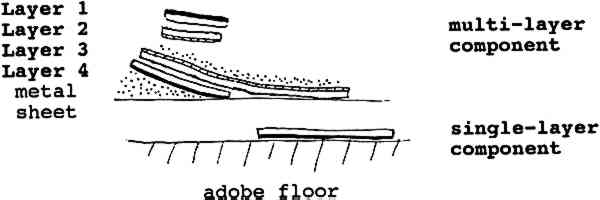FROM CODEX TO CALABASH: RECOVERY OF A PAINTED ORGANIC ARTIFACT FROM THE ARCHAEOLOGICAL SITE OF CER�N, EL SALVADORHARRIET F. BEAUBIEN
5 TREATMENTThe goals of the treatment were to identify the artifact through an investigation of structure and decoration and to reconstruct its remains as completely as possible. For each of the two components, the process featured the painstaking reassembly of fragments into individual paint layers using methods that would allow both sides to be accessible for examination whenever possible. Evidence for interpretation thus could be gathered from the reconstructed design scheme as well as from the overall pattern of impressions on the reverse. The process (described more fully below) revealed that the artifact consisted of four distinct paint layers (fig. 3), all of which were present in the component lifted by the archaeologists (the “multilayer component”). The uppermost layer (layer 1), polychromatic and oriented paint side up, was paired with a paint-side-down
The single-layer component was treated first because the fragments constituted only one layer and their configuration was relatively intact. Although oriented paint side down, they presented the most straightforward opportunity to recover an expanse of design. The backing strips applied on site were reinforced with additional Japanese tissue, secured to the irregular surface with methyl cellulose adhesive. It was overlaid with a layer of Saran Wrap, and a conforming support was cast in plaster of Paris. The block-lifted segment was then inverted, the plaster collar removed, and the adobe floor carefully excavated away. As fragments were revealed, their surfaces were cleaned, and they were consolidated thoroughly to the backing tissue with 5–10% w/v Acryloid B-72 (Rohm & Haas) in acetone. The multilayer component was then excavated with careful documentation after it was determined that imaging techniques were unlikely to provide usable information. Fragments were removed one by one using a dampened paint brush, delicately cleaned using deionized water or acetone, and edge-joined to reconstruct the individual layers. Jumbled fragments were collected in discrete groups for possible reintegration with the help of the documentation. Methyl cellulose was used whenever possible as the initial adhesive for edge-joining fragments. It provided a sufficiently strong temporary bond. At the same time, because fragments were manipulated frequently during this phase of treatment, it offered advantageous working properties, being both readily reversible and nonadhesive to glass or plastic work surfaces. The dilute Acryloid B-72 solution was found to function less flexibly and, for the purpose of initial reconstruction, to produce too effective an adhesive bond; in particular, joins were difficult to reverse without damaging the fragments. For final presentation, the layers were each secured in paint-side-up orientation to a tissue backing. Japanese tissue was used as the initial layer because of its exceptional ability to conform closely to fragment irregularities when adhered first with methyl cellulose. The fragments were then consolidated thoroughly to the backing tissue using Acryloid B-72 for strength and to reduce the risk of biodeterioration problems. Finally, leftover fragments whose original positions could not be ascertained were stored by location in polycarbonate boxes, available as untreated samples for future analysis if needed. Because of their disturbed condition, layers 1 and 2 could be reconstructed only in small islands. By contrast, the monochromatic layer 3 proved to be the most uninterrupted paint layer of the deposit and was of greatest interest for the extensive Since all other paint layers had been removed, the paint-side-down fragments comprising the bottom-most polychromatic layer (layer 4) were lifted in a single operation rather than one by one. This procedure permitted the noticeable concave curvature at the periphery of the layer to be maintained. The fragments were first backed with Japanese tissue and methyl cellulose adhesive. With a Saran Wrap separating layer, a conforming support was cast in plaster, the block inverted, and the metal sheet removed. Thatch and ash that had collected at the periphery were cleared from the fragments' paint surfaces, and these were consolidated to the tissue backing with Acryloid B-72. These fragments and those comprising the single-layer component were subsequently reunited on a single Japanese-tissue backing. |
